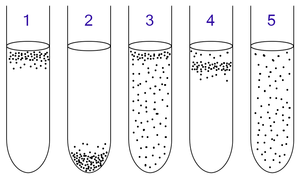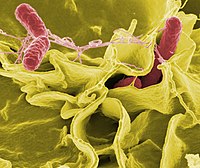Facultative anaerobic organism

1: Obligate aerobes need oxygen because they cannot ferment or respire anaerobically. They gather at the top of the tube where the oxygen concentration is highest.
2: Obligate anaerobes are poisoned by oxygen, so they gather at the bottom of the tube where the oxygen concentration is lowest.
3: Facultative anaerobes can grow with or without oxygen because they can metabolise energy aerobically or anaerobically. They gather mostly at the top because aerobic respiration generates more ATP than fermentation.
4: Microaerophiles need oxygen because they cannot ferment or respire anaerobically. However, they are poisoned by high concentrations of oxygen. They gather in the upper part of the test tube but not the very top.
5: Aerotolerant anaerobes do not require oxygen as they use fermentation to make ATP. Unlike obligate anaerobes, they are not poisoned by oxygen. They can be found evenly spread throughout the test tube.
A facultative anaerobic organism is an
Some examples of facultatively anaerobic bacteria are
It has been observed that in mutants of
There may exist a core network of transcription factors (TFs) that includes the major oxygen-responsive ArcA and FNR control the adaptation of Escherichia coli to changes in oxygen availability. Activities of these two regulators are indicative of spatial effects that may affect gene expression in the microaerobic range. It has also been observed that these oxygen-sensitive proteins are protected within the cytoplasm by oxygen consumers within the cell membrane, known as terminal oxidases.[10]
Functions
Facultative anaerobes are able to grow in both the presence and absence of oxygen due to the expression of both aerobic and anaerobic respiratory chains using either oxygen or an alternative electron acceptor.[11] For example, in the absence of oxygen, E. coli can use fumarate, nitrate, nitrite, dimethyl sulfoxide, or trimethylamine oxide as an electron acceptor.[11] This flexibility allows facultative anaerobes to survive in a number of environments, and in environments with frequently changing conditions.[1]
Several species of protists use a facultative anaerobic metabolism to enhance their ATP production, and some can produce dihydrogen through this process.[12]
As pathogens
Since facultative anaerobes are able to grow in both the presence and absence of oxygen, they can survive in many different environments, adapt easily to changing conditions, and thus have a selective advantage over other bacteria. As a result, most life-threatening pathogens are facultative anaerobes.[1]
The ability of facultative anaerobic pathogens to survive without oxygen is important since their infection is shown to reduce oxygen levels in their host's gut tissue.[13] Moreover, the ability of facultative anaerobes to limit oxygen levels at infection sites is beneficial to them and other bacteria, as dioxygen can form reactive oxygen species (ROS). These species are toxic to bacteria and can damage their DNA, among other constituents.[1]
See also
- Aerobic respiration
- Anaerobic respiration
- Fermentation
- Obligate aerobe
- Obligate anaerobe
- Microaerophile
References
- ^ S2CID 233027658.
- ISBN 9780470016176.
- ISBN 0-8385-8529-9.
- ISBN 0-471-98880-4.
- ISBN 0-12-738446-4.
- ISSN 1616-1599. Retrieved February 14, 2010.
- ^ Yamamoto, N., & Droffner, M. L. (1985). Mechanisms determining aerobic or anaerobic growth in the facultative anaerobe Salmonella typhimurium. Proceedings of the National Academy of Sciences, 82(7), 2077-2081. https://doi.org/10.1073/pnas.82.7.2077
- core.ac.uk)
- ^ Pasteur L (1857). "Mémoire sur la fermentation applée lactique" [Dissertation on the fermentation called lactic]. Comptes rendus de l'Académie des Sciences (in French). 45 (913–916): 1032–1036.
- ^ Rolfe, M. D., Ocone, A., Stapleton, M. R., Hall, S., Trotter, E. W., Poole, R. K., ... & Green, J. (2012). Systems analysis of transcription factor activities in environments with stable and dynamic oxygen concentrations. Open biology, 2(7), 120091. https://doi.org/10.1098/rsob.120091
- ^ S2CID 33083164.
- PMID 21036663.
- PMID 26104016.




